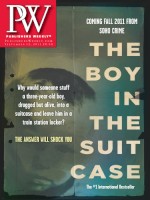Readers of fantastic fiction are no strangers to things titanic and awesome. Of late, though, these attributes have come to characterize the physical dimensions of the books, as much as the subjects of their stories: over the last few years, several retrospective anthologies of horror and fantasy fiction have appeared in volumes of considerable length.
In 2009 the Library of America brought out American Fantastic Tales, a two-volume anthology expertly edited by Peter Straub that explores the fantasy tradition as it has developed and evolved over two centuries of American short fiction. All the usual suspects are to be found within this double-decker’s near 1,500 pages: Washington Irving, Nathaniel Hawthorne, Edgar Allan Poe, H.P. Lovecraft, Shirley Jackson, Isaac Bashevis Singer, Stephen King. But some selections from the literary mainstream are sure to surprise and delight readers: A frothy fantasy from F. Scott Fitzgerald? A ghost story from Tennessee Williams? A vampire tale by John Cheever? Opening with a fragment by Charles Brockden Brown written in the late 18th century, and continuing through the 19th-century romantic movement, the 20th-century pulp fiction era, and the modern horror and fantasy movements of the postwar years, this anthology shows that a predilection for the fantastic is as old as American literature itself.
Another volume published in 2009, Otto Penzler’s The Vampire Archives (Vintage), is the most comprehensive compilation of vampire tales ever published. Its 85 selections—spanning more than 200 years and over 1,000 pages—include John Polidori’s “The Vampyre,” regarded as the first published work of vampire fiction, and “Dracula’s Guest,” an outtake from the Bram Stoker novel that forged the template for most vampire fiction written between the late-19th and late-20th centuries. Vampires of all types populate the book’s pages—scary, comic, romantic, bloodthirsty, and non-blood–drinking—and the author lineup is a veritable Who’s Who of horror: Clive Barker, Algernon Blackwood, Ray Bradbury, M.R. James, Stephen King, J. Sheridan Le Fanu, Brian Lumley, et al. Penzler even includes a section featuring vampires in verse and, for those who crave more than this banquet of blood, a bibliographic listing of nearly ever short vampire tale written up to 2009.
An equally ambitious anthology is Penzler’s just-published Zombies! Zombies! Zombies! (Vintage), which features more than 800 pages of fiction featuring the walking dead. The book’s 57 stories divided equally in their coverage of the two different approaches that define the zombie zeitgeist: the traditional zombie of voodoo folklore, and the flesh-eating zombies familiar to fans of George Romero and the films influenced by his cult classic Night of the Living Dead. Penzler’s next exhaustive anthology, featuring ghost fiction, is due from Vintage in the spring of 2012.
The 20th century was the first to yield a steady stream of horror fiction from its turn to its end, and John Pelan proves this in his two-volume mega-anthology, The Century’s Best Horror Fiction (Cemetery Dance), for which he selects one outstanding story published in each year of the century. The book is a treasure trove that mixes time-tested classics such as W.W. Jacobs’ “The Monkey’s Paw,” Algernon Blackwood’s “The Willows,” and Shirley Jackson’s “The Lottery,” with tales by Poppy Z. Brite, Ramsey Campbell, Joe R. Lansdale, and other contemporary writers who are themselves likely to be thought of as classics a hundred years hence.
If any anthology rivals all of the above titles, it is Ann and Jeff VanderMeer’s The Weird (Atlantic), forthcoming in 2012, a colossal compendium of horror, fantasy, and science fiction whose three-quarters-of-a-million words includes more than 100 stories representing over 20 different nationalities. In their efforts to show how the many different tributaries of the 20th-century weird tale—neo-Gothic, surreal, decadent, naturalistic, magic-realist, postmodern, etc.—all issue from the same fount, the VanderMeers forge provocative links between genre stalwarts such as Lovecraft, Bradbury, King, and Neil Gaiman and mainstream fabulists including Franz Kafka, Michel Bernanos, Jorge Luis Borges, Michael Chabon, Claude Seignolle, and Haruki Murakami. The contents reflect a standard of excellence that would distinguish any anthology—of non-fantasy as well as fantastic fiction.
Dziemianowicz regularly reviews books for PW and Locus.



 Volume 258
Issue 37
09/12/2011
Volume 258
Issue 37
09/12/2011





